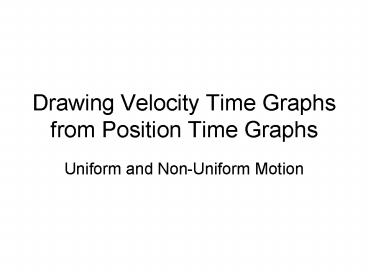Drawing Velocity Time Graphs from Position Time Graphs PowerPoint PPT Presentation
1 / 24
Title: Drawing Velocity Time Graphs from Position Time Graphs
1
Drawing Velocity Time Graphs from Position Time
Graphs
- Uniform and Non-Uniform Motion
2
Think about
- Sketch a position-time graph of each object
listed below. Describe its slope as positive or
negative, and as constant, increasing, or
decreasing. - A) a stone at rest
- B) a jogger moving steadily to the right
- C) a bicycle moving to the left and slowing down
- D) a rocket moving up at an increasing speed
- E) a stone falling freely with increasing speed
- F) a parachutist drifting down at a steady speed
3
Non-Uniform Motion
- An object does not always move at a constant
speed. - You may speed up or slow down.
- Non-uniform motion, when graphed, appears as a
curve not a straight line.
4
Instantaneous Velocity
- When you are driving on the highway and you look
down at your speedometer, you are traveling at
55 km/h. At that instant in time, 55 km/h is
your instantaneous velocity. - For uniform motion, your instantaneous velocity
is the same as you average velocity. - For non-uniform motion, your instantaneous
velocity changes.
5
Finding Instantaneous Velocity from a Graph
(Uniform Motion)
- To find instantaneous velocity on a uniform
position-time graph, just find the average
velocity for the given segment.
6
Finding Instantaneous Velocity from a Graph
(Non-Uniform Motion)
- To find instantaneous velocity on a non-uniform
position-time graph, draw a line that is tangent
to the curve at that point. - The slope is the instantaneous velocity (take the
two points on the tangent from each side of the
point).
7
http//en.wikipedia.org/wiki/Tangent
8
(No Transcript)
9
Instantaneous Velocity (Non-uniform Motion)
10
Worksheet
11
What does a v-t graph look like?
- Time is marked on the horizontal axis and
velocity is on the vertical. - Graphs that represent an objects velocity versus
its time.
12
What can we determine from a velocity time graph?
- Velocity and speed
- Time
- Acceleration
- Displacement and distance
13
What can we determine from a velocity time graph?
- Velocity - reading directly off the y-axis
14
What can we determine from a velocity time graph?
- Time (read off the x-axis)
15
What can we determine from a velocity time graph?
- Displacement area under the curve
- NOTE Area formulas
- Arearectangle length x width
- Areatriangle ½ base x height
16
What can we determine from a velocity time graph?
- Acceleration v/t slope
17
What can you find from a v-t graph
- Acceleration slope at a point on the graph (you
may have to use a tangent) - Average acceleration finding the slope of a
segment (use the start and end points)
18
Interpreting v-t graphs
- Horizontal lines show uniform motion (constant
speed and direction). - Inclined lines show change in speed or direction,
or both in other words accelerated motion.
19
Velocity-Time Graphs
20
Worksheet
21
- How can we use d-t graphs to determine v-t
graphs? - Find the velocity for each section of the graph
and plot it (make a list of points).
22
(No Transcript)
23
(No Transcript)
24
Page 57
- Page 57, question 4
- Page 58, question 5
- Worksheet

